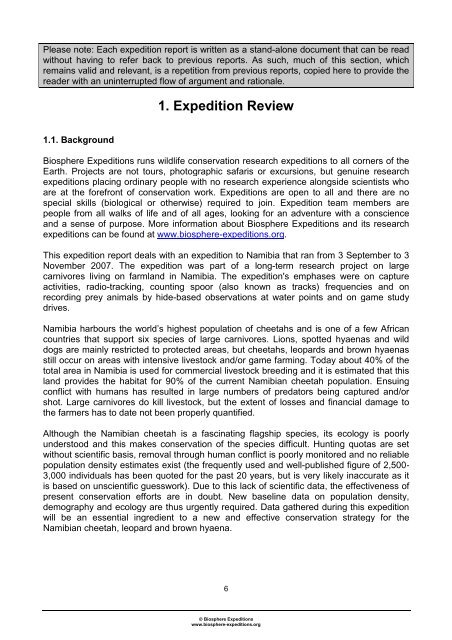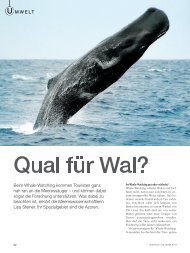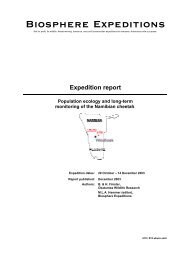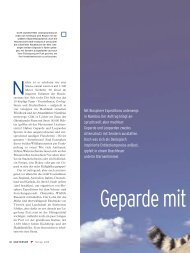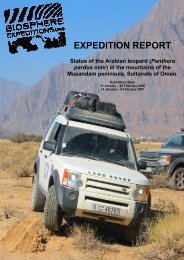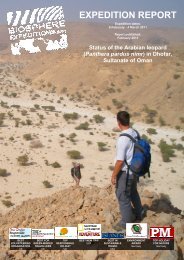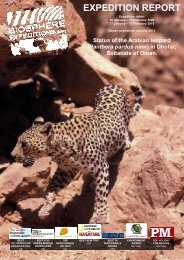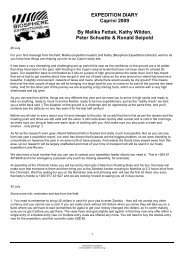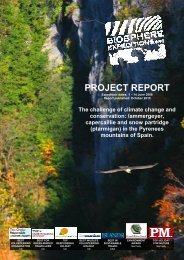EXPEDITION REPORT - Biosphere Expeditions
EXPEDITION REPORT - Biosphere Expeditions
EXPEDITION REPORT - Biosphere Expeditions
You also want an ePaper? Increase the reach of your titles
YUMPU automatically turns print PDFs into web optimized ePapers that Google loves.
Please note: Each expedition report is written as a stand-alone document that can be read<br />
without having to refer back to previous reports. As such, much of this section, which<br />
remains valid and relevant, is a repetition from previous reports, copied here to provide the<br />
reader with an uninterrupted flow of argument and rationale.<br />
1.1. Background<br />
1. Expedition Review<br />
<strong>Biosphere</strong> <strong>Expeditions</strong> runs wildlife conservation research expeditions to all corners of the<br />
Earth. Projects are not tours, photographic safaris or excursions, but genuine research<br />
expeditions placing ordinary people with no research experience alongside scientists who<br />
are at the forefront of conservation work. <strong>Expeditions</strong> are open to all and there are no<br />
special skills (biological or otherwise) required to join. Expedition team members are<br />
people from all walks of life and of all ages, looking for an adventure with a conscience<br />
and a sense of purpose. More information about <strong>Biosphere</strong> <strong>Expeditions</strong> and its research<br />
expeditions can be found at www.biosphere-expeditions.org.<br />
This expedition report deals with an expedition to Namibia that ran from 3 September to 3<br />
November 2007. The expedition was part of a long-term research project on large<br />
carnivores living on farmland in Namibia. The expedition's emphases were on capture<br />
activities, radio-tracking, counting spoor (also known as tracks) frequencies and on<br />
recording prey animals by hide-based observations at water points and on game study<br />
drives.<br />
Namibia harbours the world’s highest population of cheetahs and is one of a few African<br />
countries that support six species of large carnivores. Lions, spotted hyaenas and wild<br />
dogs are mainly restricted to protected areas, but cheetahs, leopards and brown hyaenas<br />
still occur on areas with intensive livestock and/or game farming. Today about 40% of the<br />
total area in Namibia is used for commercial livestock breeding and it is estimated that this<br />
land provides the habitat for 90% of the current Namibian cheetah population. Ensuing<br />
conflict with humans has resulted in large numbers of predators being captured and/or<br />
shot. Large carnivores do kill livestock, but the extent of losses and financial damage to<br />
the farmers has to date not been properly quantified.<br />
Although the Namibian cheetah is a fascinating flagship species, its ecology is poorly<br />
understood and this makes conservation of the species difficult. Hunting quotas are set<br />
without scientific basis, removal through human conflict is poorly monitored and no reliable<br />
population density estimates exist (the frequently used and well-published figure of 2,500-<br />
3,000 individuals has been quoted for the past 20 years, but is very likely inaccurate as it<br />
is based on unscientific guesswork). Due to this lack of scientific data, the effectiveness of<br />
present conservation efforts are in doubt. New baseline data on population density,<br />
demography and ecology are thus urgently required. Data gathered during this expedition<br />
will be an essential ingredient to a new and effective conservation strategy for the<br />
Namibian cheetah, leopard and brown hyaena.<br />
6<br />
� <strong>Biosphere</strong> <strong>Expeditions</strong><br />
www.biosphere-expeditions.org


